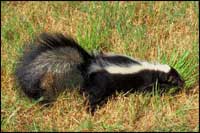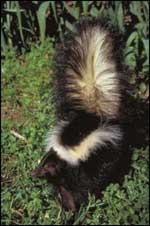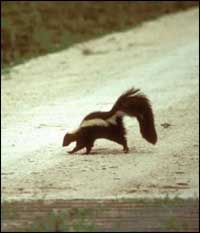Skunks
Few woodland creatures can stop a person in his or her tracks as fast as the skunk. If you know anything about skunks, you realize that this reaction comes from a healthy respect for the animal's ability to spray an extremely smelly fluid at anyone who bothers it.
Humans are not the only ones who wisely stay out of the skunk's range. When that potent spray hits, it leaves a lasting impression, and few creatures risk a second encounter. The skunk's defense is so effective that it is seldom attacked; however, coyotes and the great-horned owl do occasionally kill and eat the small mammal.

Insects and grubs make up at least half of a skunk's year-round diet, and may be what this skunk is hunting for.
Five species of skunks are found in Texas, but you probably won't ever meet one kind – the hooded skunk – unless you live in the Big Bend region. It is considered a Mexican species and has been seen only in Brewster, Presidio, Jeff Davis, Terrell, and Val Verde counties. The other four are the spotted, striped, and two species of hog-nosed skunks.
If you were asked to describe a skunk, you probably would say that it is black with a broad, white stripe that runs from the top of its head to the tip of its tail. That's the way skunks are drawn in cartoons, but in reality, this description fits only the hog-nosed and the relatively rare Gulf Coast hog-nosed skunks in Texas. These two are very similar in looks but the Gulf Coast species has a narrower stripe down its back and is the largest of all North American skunks. It is found in the area from Brownsville north along the coast to Aransas Pass and has been recorded in Aransas, Brooks, Cameron, Kleberg, Nueces, and Webb counties. If you live in the Edwards Plateau region of Central Texas, the Chisos, Davis, or Guadalupe mountains of the Trans-Pecos, or the Big Thicket area of East Texas, you will be in the range of the hog-nosed skunk. Its hoglike habit of rooting around for food has caused it to be called the "rooter skunk," and you may see signs of its plowing and rooting.
A small white spot on its forehead and another in front of each ear gives the spotted skunk its name. Four stripes extend from its head down its back and additional white stripes and spots are found on other parts of its body. This skunk is an excellent mouse catcher, and you may find it denned in or near a barn. Occasionally the spotted skunk develops a taste for eggs and chickens, which makes it an unwelcome guest on the farm.
The striped skunk has a white stripe that starts at the top of its head, splits at the neck, and extends down each side of its body. The width of this stripe and the amount of white on the tail may vary from one skunk to another. This species has been found in all parts of the state.

The striped skunk has a white stripe that starts at the top of its head, splits at its neck, and extends down each side of its body.
Have you ever wondered what a skunk eats? Studies show that at least half of its year-round diet is insects and grubs. Bees and wasps, as well as their larvae, honey, and nests, also are favorite items on the menu. Mice and other rodents fill in one-fourth of the diet, and vegetable matter one-tenth. A mixture of spiders, reptiles, amphibians, birds and their eggs, millipedes, and centipedes rounds out the menu.
Although many of its eating habits are quite helpful to man, its defensive spray makes it an undesirable visitor. Let's take a closer look at the skunk's spraying system and how it works.
Two musk sacs or glands contain the foul-smelling ammunition – a clear, golden-yellow sulphide fluid known as n-butyl mercaptan. These glands are located just inside the anal tract on either side of the skunk's rectum. The odor of this liquid is enough to discourage most enemies, but in addition to the awful smell, it also burns and stings when it touches the skin. A direct hit in the face causes painful but temporary blindness and severe inflammation of the eyes, nose, and mouth. Choking, coughing, some degree of nausea, and possible fainting also may result.
The musk is discharged from the glands through two ducts (tubes for carrying the fluid) that are hidden within the rectum when not in use. As the tail is raised, these nozzlelike ducts stick out for service and can be shot separately in any direction at any height. Don't think you are safe from the spray just because the skunk’s rear is pointing in the other direction. Although it usually turns to fire, the animal can shoot to the right, left, front, and back without turning around. It also may rear up on its front legs, as if doing a handstand, and spray forward over its head.
If you think the skunk can fire its weapon only once, you are in for a bad surprise. Each gland holds about one tablespoon of the thick, oily musk, and it can be released in controlled amounts to give the animal five or six shots from each gland. Once the supply runs out, several days are needed to completely refill the musk sacs, but they are workable in about a day.

Skunks are able to spray a truly offensive order, and they can and will bite.
Although the distance at which a skunk can accurately hit its target varies, anything within ten to twelve feet of the animal is usually in range. With a little help from the wind, more distant targets can be hit. Remember this, and don't get too close when you watch this creature.
Many naturalists believe that a skunk cannot use its spray if it is held suspended by the tail. Even though this may be true, getting close enough to pick up the skunk to make it harmless is dangerous business, and you should think about the time when the skunk has to be put down. You can't hold one by the tail forever.
Since the skunk usually is a gentle, nonaggressive creature that only uses its terrible weapon for defense, the best way for you to avoid its spray is to leave the animal alone. When threatened, the skunk may give three warnings before actually spraying. First, it lowers its head, arches its back, and lifts its tail, except for the tip, which hangs limp. If the enemy doesn't back off, the skunk then rapidly stamps its front feet. Finally it lifts the tip of the tail and prepares for battle. However, if surprised or threatened, the skunk shoots immediately without warning.
If you happen to meet a skunk in the woods, stand as still as possible for a few minutes. As soon as the animal feels you are no threat, it will go about its business, and you can quietly slip away without being sprayed. However, if you or the family pet are unlucky enough to clash with a skunk, you might like to know that although there are many home remedies to remove skunk smell, apple cider vinegar seems to be the most effective. Rub it directly on the sprayed area before bathing, and soak your clothes in it before washing them.
The best advice to follow is leave skunks alone – baby ones included. Don't let the sight of a cute little skunk tempt you into trying to pick it up.
Young skunks are able to spray by the time they are seven weeks old, and they won't hesitate to let you have it. Also, they can and will bite. According to the Texas Department of Health, skunks are the primary carriers of rabies in Texas and account for 73 percent of the reported cases. Be especially wary of “friendly” skunks, since one of the characteristics of rabies in wildlife is a loss of fear of humans.
Ilo
Hiller
1990 – Skunks: Introducing Mammals to Young
Naturalists. The Louise
Lindsey Merrick Texas Environment
Series, No. 10, pp. 43-46.
Texas A&M University
Press, College Station.